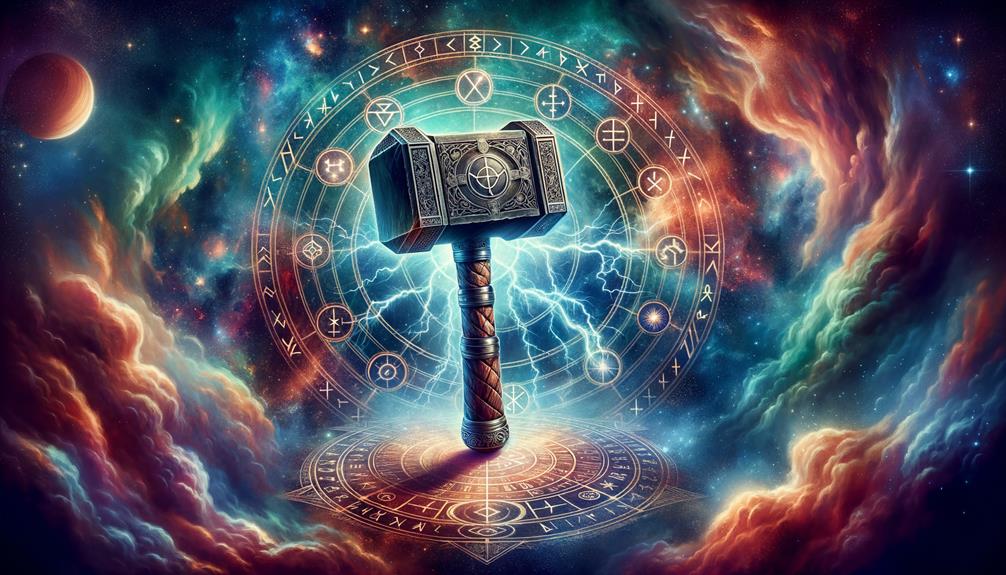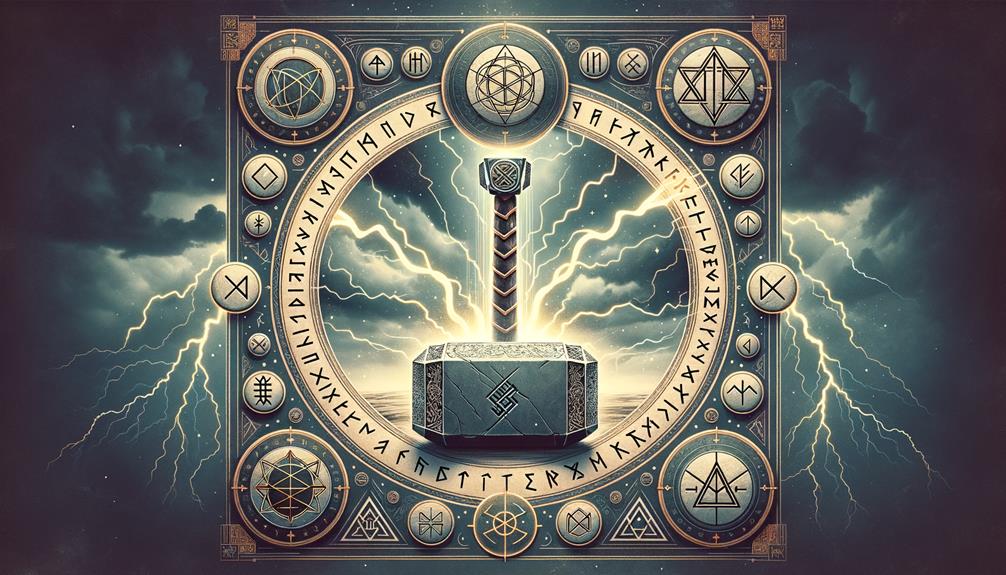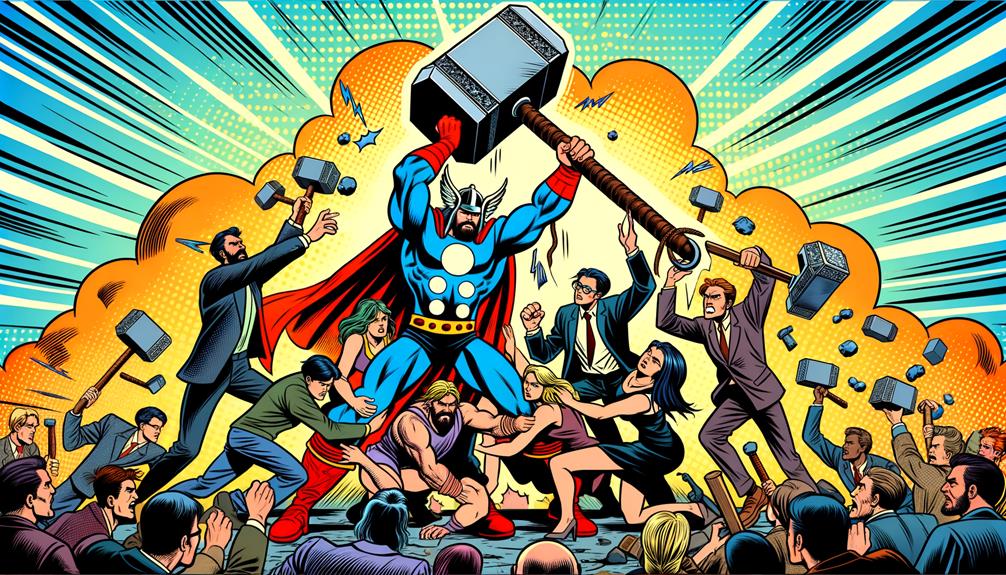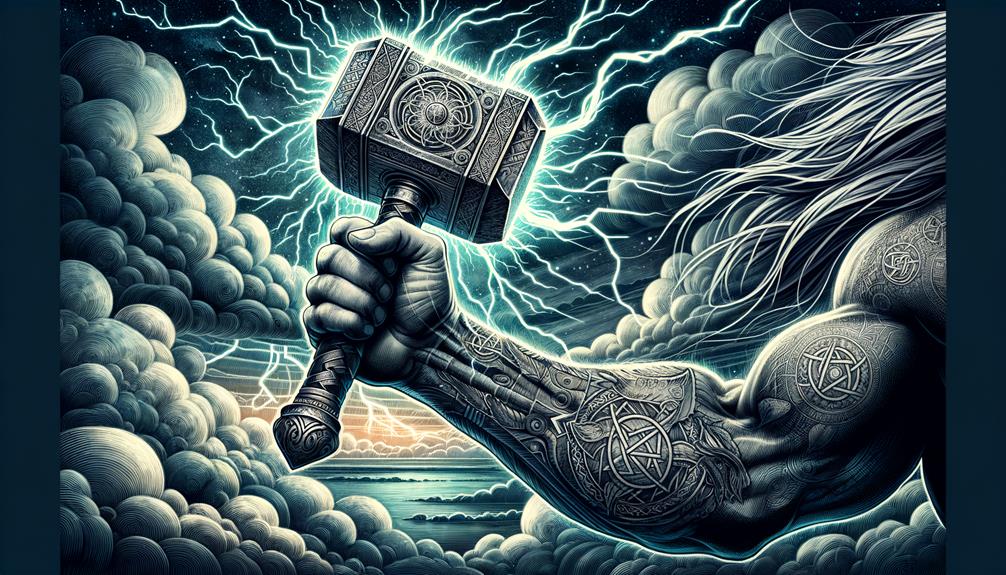Have you ever heard of Mjolnir? It's the impressive hammer of Thor, a thunder god from Norse mythology. This legendary weapon wasn't just forged anywhere, it was created in the core of a dying star. But Mjolnir is more than a destructive tool; it's a symbol that's deeply rooted in myth and mystery. I've spent numerous hours pouring over old texts and artifacts, trying to solve the puzzle that is Mjolnir. Its unique construction from uru metal, its magical worthiness clause, and its ability to manipulate gravity – these factors make it incredibly intriguing. But the true strength of Mjolnir is its importance in Norse culture – not just as a weapon, but also as a tool used in rituals and as a symbol of bravery. But don't think we're done just yet. There's a lot more to learn about Mjolnir, and once we uncover those secrets, the true importance of this mythological hammer will shine through.
The Mythological Origins of Mjolnir

If we take a peek into the mythological roots of Mjölnir, we see it closely linked to the Norse thunder god Thor, as documented in ancient works such as the Poetic Edda and Prose Edda. More than just a weapon, Mjölnir or Thor's hammer, held immense value and was a pivotal symbol in Norse mythology.
During the Viking Age, Mjölnir, also known as Thor's hammer, was typically worn as a pendant – a charm symbolizing Thor's protection. A noteworthy artifact, the Kvinneby amulet discovered in Sweden, openly summons Thor and his hammer for aid and blessings. This emphasizes the crucial role Mjölnir played in the Norse belief system.
The legendary significance of Mjölnir is further underlined in stories of Thor's confrontations with the malevolent jötnar, a giant race, and the hammer's theft by the giant Þrymr. The abundant pendants unearthed across Nordic countries, as well as objects like the Eyrarland Statue, offer archaeological proof of Thor's connection with his hammer.
Historical References to Thor's Hammer

Let's shift our focus to Thor's hammer, also known as Mjölnir, in historical texts. It crops up in numerous sources like the Kvinneby amulet, the Poetic Edda, and the Prose Edda. All these references validate the crucial part Mjölnir played in Norse mythology. The Kvinneby amulet, a Swedish artifact, shows Thor holding his hammer, emphasizing their close bond.
During the Viking Age, many people sported Mjölnir pendants, which confirms the hammer's importance in Norse culture. These relics usually tie back to Thor's fights against the destructive jötnar. A classic example of this can be seen in the Þrymskviða, where Mjölnir is cleverly taken back from the jötunn Þrymr.
Additionally, Latin texts from figures such as Adam of Bremen and Saxo Grammaticus offer more historical mentions of Thor's hammer. They describe Thor brandishing hammer-like items, linking the myth to physical evidence and hinting at a true respect for Mjölnir in real life.
What's intriguing is that Mjölnir wasn't just a fighting tool. It was also used in celebrations of births, marriages, and possibly even funerals. While we can't confirm that Mjölnir was made from uru metal, like in Marvel's depiction, it's evident that this hammer was, and still is, fundamental to the legacy of the Norse gods.
Mjolnir's Unique Powers and Abilities

Let's get to know more about the awe-inspiring abilities and powers of Mjolnir, the legendary hammer of Thor. This isn't just an ordinary hammer; it's a symbol of divine authority and a key figure in Norse mythology.
In the realm of Marvel, the Mjolnir's origin story is quite extraordinary. It was crafted in the core of a dying star, where Odin, the All-Father, had trapped the mighty God Tempest. This act infused the hammer with cosmic power. Here's a peek at what Mjolnir can do:
- Mjolnir was fashioned from a piece of Uru, a magical and incredibly resilient substance. Its main power lies in its ability to focus and enhance Thor's innate abilities, such as control over storms and lightning.
- The hammer shares a mystical bond with Thor. This allows it to change its course mid-air and fly back to Thor's hand.
- Mjolnir has the ability to alter its mass using graviton particles, which means it can land blows that could literally shake the earth.
- And of course, the famous enchantment by Odin. It ensures that only those deemed 'Worthy of Mjolnir' can lift it. This is a safeguard to ensure the hammer's power is wielded responsibly.
The combination of these unique characteristics, along with its symbolic significance in Norse rites, positions Mjolnir as an incredible symbol of divine power and authority.
Interpretations and Symbolism of Mjolnir

When you delve into the symbolism of Mjolnir, you realize it's not just a weapon of Thor. It's a strong symbol of authority, power, and divine protection in the lore of the Norsemen. Only those who are judged worthy can lift Mjolnir, which signifies the esteemed privilege of divine authority. If Thor puts down the hammer, only someone deemed worthy can pick it up. This is written as, 'Whosoever holds this hammer, if he be worthy, shall possess the power of Thor.'
Mjolnir's significance also extends into contemporary interpretations. It is a common sight in popular culture, where its image symbolizes strength, courage, and protection. Let's quickly scan its various symbolic interpretations:
| Interpretation | Meaning |
|---|---|
| Authority | Only the worthy can lift the hammer |
| Power | The holder of this hammer will have the power |
| Protection | Thor uses it to safeguard the realms |
| Strength | Lifting Mjolnir requires immense strength |
When we talk about Mjolnir, we're not just talking about Thor's weapon. This hammer is a powerful symbol of authority, power, and divine protection in Norse mythology. Only those who are deemed worthy can lift Mjolnir, symbolizing the privilege of divine authority. According to the inscription, 'Whosoever holds this hammer, if he be worthy, shall possess the power of Thor,' only someone worthy can lift the hammer when Thor places it down.
The symbolism of Mjolnir is not limited to ancient times; it also extends to modern interpretations. In today's popular culture, its image often represents strength, courage, and protection. Here's a brief rundown of its various symbolic interpretations:
| Interpretation | Meaning |
|---|---|
| Authority | Only the worthy can lift the hammer |
| Power | The holder of this hammer will have the power |
| Protection | Thor uses it to safeguard the realms |
| Strength | Lifting Mjolnir requires immense strength |
Mjolnir's Presence in Popular Culture

Mjolnir is not just a symbol of history and mythology; it's also become a significant player in popular culture. This is an emblem of Norse myth that's found its way into many forms of media. What's the reason behind its fame? Well, one could argue it's due to its role in the Marvel Universe. Here, Mjolnir is seen in the hands of Thor, the god of thunder, and even Captain America from time to time.
Let's take a look at where Mjolnir pops up in popular culture:
- Marvel Comics: Here, Mjolnir is a pivotal element. It boosts Thor's power and sets the criteria for who can handle it.
- Film and Television: In the Marvel films and TV shows, Mjolnir is a star, cementing its place in culture.
- Merchandising: Everything from toys to clothes carry Mjolnir's image, giving it global fame and reinforcing its pop culture standing.
- Neopaganism: Mjolnir pendants are sported as symbols of faith and power, showing its spiritual sway.
In 'Thor's Hammer Mjolnir Explained', I've tried to peel back the layers of Mjolnir's story. I've looked at everything from its legendary beginnings to its current cultural impact. From a pop culture perspective, we can really see why this ancient symbol has stood the test of time.
Frequently Asked Questions
Why Can Only Thor Lift Mjolnir?
So, why is Thor the only one able to pick up Mjolnir? Well, it's all down to a spell cast by Odin. This spell means that only those who are truly deserving can handle it. It's a beautiful reflection of Thor's righteousness and strong moral fibre, which really brings depth to his character as a hero.
How Does Mjolnir Decide Who Is Worthy?
So you're curious about Mjolnir and how it figures out who's worthy, eh? Well, let's break it down.
Mjolnir's special trick of choosing a worthy holder isn't magic, but a clever use of nanotechnology. This tiny tech checks out someone's physical and mental make-up. If it doesn't like what it sees, it'll turn on the graviton emitters. These little guys make Mjolnir too heavy to move for anyone it deems unworthy. This way, only the ones Mjolnir thinks are up to the task can lift it.
What Does Thor's Hammer Mjolnir Mean?
In Norse mythology, Mjolnir, the hammer of Thor, stands as a symbol of protection and the enforcement of order among the gods. This formidable weapon is a testament to Thor's authority and power. It often takes center stage in stories and rituals, and during the Viking Age, folks even wore it as a pendant. It's a fascinating piece of history that tells us a lot about the beliefs and culture of that time.
Who Can Lift Mjolnir Without Being Worthy?
In the world of Marvel, it's generally believed that only those deemed worthy can lift Mjolnir. But, there are times when this rule has been bent a bit. For instance, take Hulk who managed to lift it with sheer brute force, or Loki who employed his cunning to do the same. So, it's safe to say that the rules aren't always as black and white as they appear.

